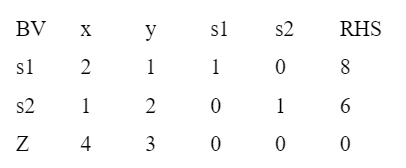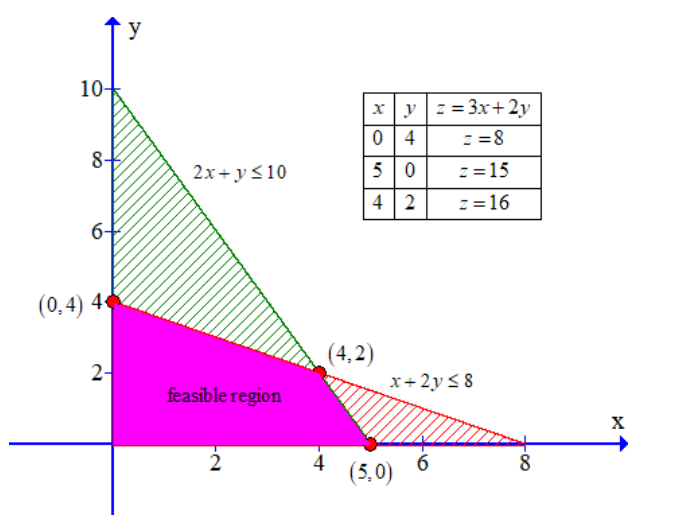

Linear programming is a sophisticated mathematical approach for optimising solutions to a wide range of real-world situations. It entails maximising or minimising a linear objective function while keeping linear limitations in mind. Applications span from industrial resource allocation to logistical planning. The method employs graphical and algebraic methodologies to select the best viable solution from a set of options, offering useful insights for decision-making processes..
Linear programming is a mathematical optimisation approach that seeks to maximise or minimise a linear objective function that is constrained by a linear function. It is widely used in resource allocation, production planning, and logistics. Linear programming finds the best solution among viable choices using graphical and algebraic approaches. It assists organisations and industries in making informed decisions by translating real-world issues into mathematical models, therefore increasing efficiency and effectiveness..


Linear programming includes the following components:
These elements combine to produce a linear programming issue, which is then solved mathematically to discover the best solution.
To handle linear programming issues, there are two basic approaches:
For problems with multiple variables, the simplex method is used to iteratively find the optimal solution by moving from one vertex (corner point) of the feasible region to another.
Example:
Maximize Z = 4x + 3y
Solution:
Step 1: Convert the inequalities into equations (equalities) by introducing slack variables.
Step 2: Set up the initial Simplex Table:

Step 3: Perform iterations to find the optimal solution.
Choose the most negative value in the Z-row as the pivot column.
Divide the corresponding RHS value by the pivot column value to determine the pivot row.
Perform elementary row operations to make the pivot element 1 and other elements in the pivot column zero.
Repeat these steps until all values in the Z-row are non-negative.
After iterations, the optimal solution is found as x = 2, y = 2, and Z = 14.
This method is suitable for problems with only two decision variables. It involves plotting the constraints on a graph and visually identifying the optimal solution.
Example:
Maximize Z = 3x + 2y
Solution:
Step 1: Plot the feasible region determined by the constraints.

Step 2: Calculate the value of the objective function (Z) at each corner point of the feasible region.
A (0, 4) => Z = 3(0) + 2(4) = 8
B (4, 2) => Z = 3(4) + 2(2) = 16
C (5, 0) => Z = 3(5) + 2(0) = 15
Step 3: Identify the corner point with the highest Z value; it corresponds to the optimal solution.
The optimal solution is at point B (4, 2), where Z = 16
Also Check For:


Linear programming finds applications in various fields due to its ability to optimize solutions subject to linear constraints. Here are some common applications with explanations:
These applications demonstrate the versatility and practical significance of linear programming in various industries and decision-making processes, helping businesses and individuals make informed choices and improve overall efficiency.
The importance of linear programming lies in its wide range of applications and its ability to optimize solutions effectively. Here are the key points highlighting its significance:
Overall, linear programming plays a crucial role in modern problem-solving, planning, and decision-making processes across various industries, helping organizations achieve their objectives while making the best use of available resources.
Linear programming is a mathematical approach for solving problems that have linear constraints. It entails maximising or minimising a linear objective function that is constrained by linear inequality. A manufacturing business, for example, might utilise linear programming to identify the ideal production mix of multiple goods while taking resource limits and profit targets into account, resulting in efficient resource allocation and greater profitability.
The three steps of linear programming are as follows: Defining the Objective Function: Create a linear equation that represents the aim to maximise or minimise Creating Constraints: Create linear inequalities or equations that indicate the decision variables' constraints. To discover the best practicable solution that optimises the objective function within the restrictions, use mathematical approaches such as graphical analysis or the simplex algorithm.
Maximisation: The goal is to maximise the value of the linear objective function while keeping restrictions in mind. Minimization: Within the specified limitations, the goal is to minimise the value of the linear objective function. movement: The optimisation of products movement from numerous sources to various destinations while minimising transportation expenses. Assignment is concerned with allocating resources to jobs in the most efficient manner possible while keeping cost and time restrictions in mind. Diet Problem: Attempts to determine the most cost-effective combination of meals to suit nutritional needs.
A manufacturing business attempting to optimise its production mix in order to maximise revenues is one example of linear programming. The goal is to establish the amounts of various items to create while taking into account resource restrictions such as labour hours, machine availability, and raw resources. The corporation may utilise linear programming to identify the best production quantities by defining a linear objective function and constraints, resulting in greater efficiency and profitability.
Because both the goal function and the restrictions are expressed as linear equations or inequalities, it is termed linear programming. The term linear refers to the fact that the coefficients of the variables in the equations are constant (not raised to any power) and that there are no variable interactions or products. Because of this linearity feature, effective mathematical approaches may be used to solve the optimisation issue.
The two forms of Linear Programming Problems (LPP) are: Standard Form: Involves maximizing the objective function subject to constraints, where all decision variables are non-negative, and the equations are in the form of ≤. Canonical Form: Requires minimizing the objective function subject to constraints, where decision variables are non-negative, and the equations are in the form of ≥.
George Dantzig is widely regarded as the Father of Linear Programming. Dantzig invented the simplex algorithm, a game-changing approach for tackling linear programming problems, in 1947. His work transformed optimisation approaches, resulting in substantial advances in domains such as operations research, logistics, and economics. Dantzig's innovations have had a significant influence on linear programming and optimisation applications in practise.
The optimal value of the objective function produced by solving a Linear Programming Problem (LPP) is the LPP solution. It is the best possible solution that maximises or minimises the objective function while meeting all of the restrictions.
Linear Programming Optimisation (LPP) is another name for Linear Optimisation.
Linear Programming (LPP) has the following limitations: Linearity Assumption: Linear connections between the goal function and restrictions are required for LPP, which may not correctly describe complicated real-world events. In large-scale situations, the amount of variables and restrictions might become computationally complex. LPP offers continuous solutions, which may not always be viable in discrete decision-making circumstances. Sensitivity to Input Parameters: Minor changes in data might result in drastically different answers, reducing the dependability of outcomes. Infeasibility: Due to competing restrictions or unbounded areas, certain problems may have no possible solutions.
Linear Programming Problems (LPP) include the following characteristics: Linear equations or inequalities are used to express both the goal function and the limitations. Additivity: The contributions of choice factors in the objective function and restrictions are additive. Proportionality refers to the connection between variables and the objective function. confidence: All of the model's parameters, coefficients, and constants are known with confidence. Decision variables can be continuous or fractional in nature, allowing for partial solutions. Non-negativity: Decision variables must be non-negative (equal to or greater than zero). Optimality: maximising or minimising the objective function while meeting the restrictions. Because of these properties, LPP is suited for a wide range of applications, allowing for efficient optimisation in decision-making processes.